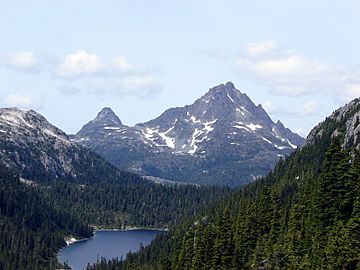Insular Mountains facts for kids
Quick facts for kids Insular Mountains |
|
|---|---|
| French: Monts Insulaires | |

Golden Hinde, south aspect, August 2006.
|
|
| Highest point | |
| Peak | Golden Hinde, Vancouver Island |
| Elevation | 2,196.818 m (7,207.41 ft) |
| Dimensions | |
| Area | 133,879 km2 (51,691 sq mi) |
| Geography | |
| Country | Canada |
| Province | British Columbia |
| Parent range | Pacific Cordillera |
The Insular Mountains are a group of mountains in British Columbia, Canada. They include the Vancouver Island Ranges and the Queen Charlotte Mountains.
These mountains are very rugged, especially on Vancouver Island. Here, some peaks in Strathcona Provincial Park are taller than 2,000 meters (about 6,560 feet). The tallest mountain is Golden Hinde on Vancouver Island. It stands at 2,197 meters (7,208 feet) tall.
Even though the Coast Mountains are often called the westernmost mountains in Canada, the Insular Mountains are actually the ones furthest to the west.
Contents
How the Insular Mountains Formed
The Insular Mountains are not fully above sea level today. Vancouver Island and Haida Gwaii are just the highest parts of this mountain range. During the last ice age (about 18,000 years ago), the sea level was much lower. This made the entire range, including the continental shelf, a wide flat land.
These mountains were created when a chain of active volcanic islands crashed into the North American continent. This happened during the middle of the Cretaceous period, a long time ago.
The rocks that make up the Insular Mountains are mostly turbidites and pillow lavas. You won't find much granite here, which is different from the Coast Mountains. The Insular Mountain range covers a huge area, about 133,879 square kilometers (51,691 square miles).
Earthquakes and Glaciers
The Insular Mountains often experience earthquakes. This is because the Pacific Plate and the Juan de Fuca Plate are slowly sliding under the Earth's mantle. Big earthquakes have caused mountains to collapse, leading to landslides and cracks in the ground.
During the last ice age, almost all of these mountains were covered in ice. Huge glaciers flowed down to the Pacific Ocean. They carved out the sides of the valleys and dug deep into their bottoms.
When the ice melted and the sea level rose, these valleys filled with water. They became what we now call fjords. You can still see signs of the Ice Age today, like the Comox Glacier in the Vancouver Island Ranges.
Parts of the Insular Mountains
The Insular Mountains are divided into smaller groups of mountains called sub-ranges.
Mountains of Haida Gwaii
The Queen Charlotte Mountains are found on Haida Gwaii. They include:
- Cameron Range: On the western side of Graham Island.
- Crease Range: In north-central Graham Island.
- McKay Range: On the south coast of Graham Island.
- San Christoval Range: On the western side of Moresby Island.
Mountains of Vancouver Island
The Vancouver Island Ranges are located on Vancouver Island. They include:
- Refugium Range: On the Brooks Peninsula.
- Sophia Range: On Nootka Island, between Esperanza Inlet and Nuchatlitz Inlet.
- Genevieve Range: Also on Nootka Island.
- Karmutzen Range: Between Nimpkish Lake, Tlakwa Creek, and Karmuzten Creek.
- Hankin Range: Between Nimpkish Lake and Bonanza Lake.
- Franklin Range: Near Robson Bight on the Johnstone Strait.
- Bonanza Range: Between the Nimpkish River and the Tsitika River, near Bonanza Lake.
- Sutton Range: Between Nimpkish River, White River, Oktwanch River, and Gold River.
- Newcastle Ridge: Near Johnstone Strait, west of Sayward-Kelsey Bay.
- Prince of Wales Range: On the east coast of Vancouver Island, north of Campbell River.
- Halifax Range: Along Johnstone Strait, between Amor de Cosmos Creek and Pye Creek.
- Beaufort Range: North of Port Alberni and west of Qualicum Beach.
- Pelham Range: Between the Sarita River and Alberni Inlet.
- Somerset Range: Between The Pacheena-Sarita River basins and the Klanawa River.
- Seymour Range: Between the valley of Cowichan Lake, San Juan River, and Gordon River.
- Gowlland Range: Near Victoria, between Saanich Inlet and Brentwood Bay. This includes Mount Work Regional Park.
- Pierce Range: South of Gold River, between the Jacklah River and the Burman River.
- Haihte Range: Between Tashsis River, the Nomash River, Zeballos Lake, and Woss Lake.
The Elk River Mountains, found in Strathcona Provincial Park, are sometimes also considered a range.


